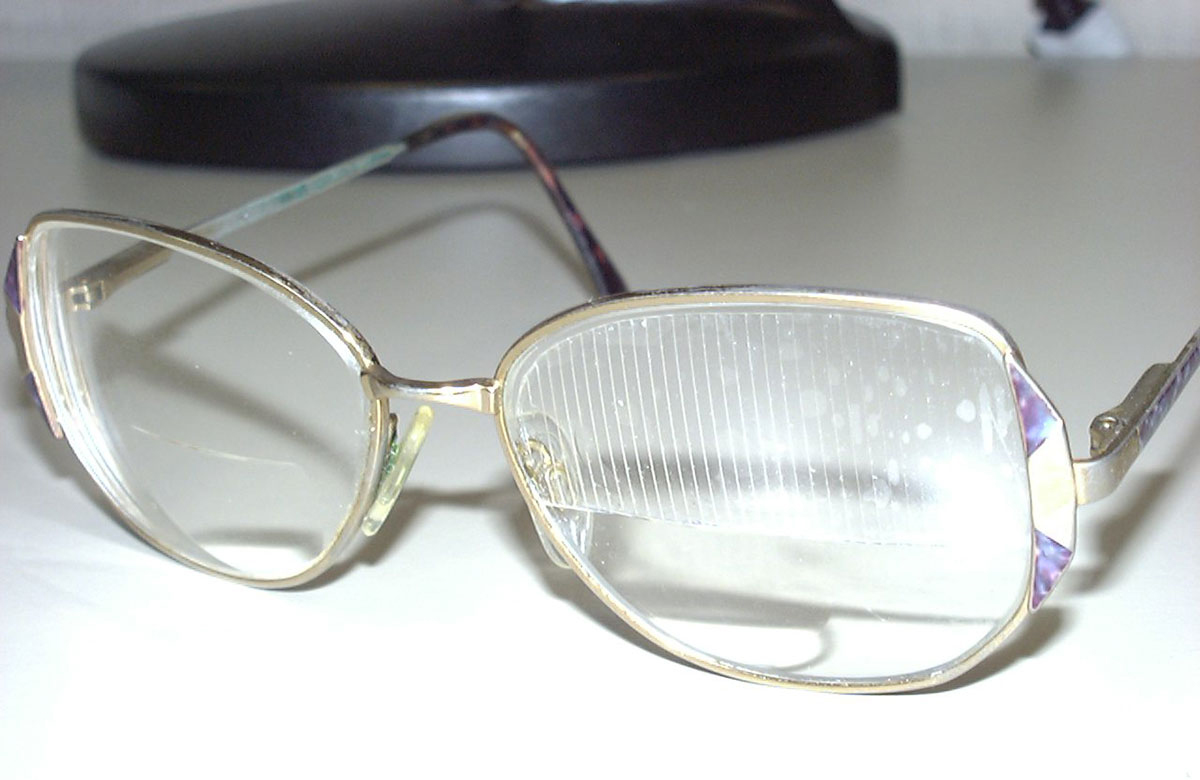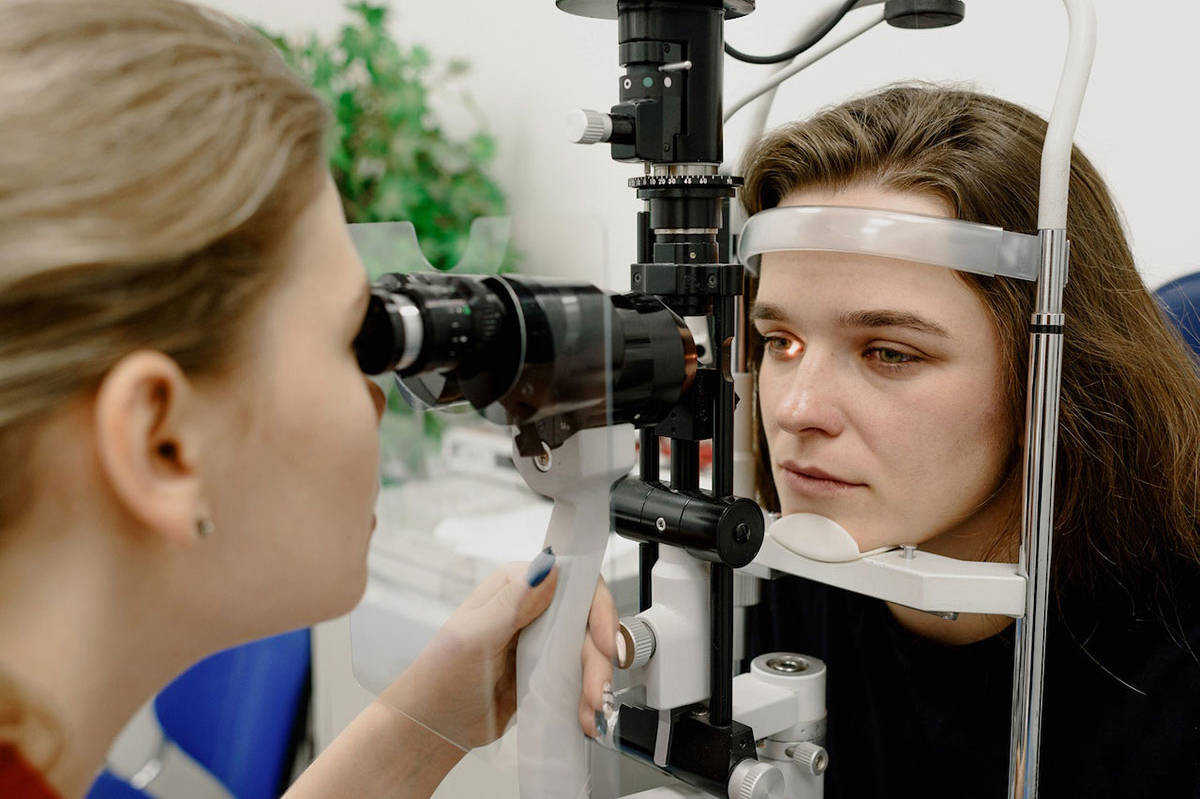What Are Prism Glasses & Do You Need Them?
Prism glasses are glasses with (you guessed it) prism lenses. Like the name implies, many prism lenses have a wedged or triangular shape to help people with conditions like Binocular Vision Dysfunction (BVD) and double vision to see better.
Keep in mind you’ll need a doctor’s prescription to use prism glasses.
How do prism glasses work?
Many of those suffering from eye misalignment cannot see just one image because their two eyes are looking in slightly different directions. This causes conditions such as BVD, double vision, headaches, motion sickness, and more. Prism glasses are designed to help with this.
There are two main types of prisms used on these glasses: press-on Fresnel films (which we’ll talk about in the next section) and ground-in prisms. Ground-in prisms are made by optical shops and have a triangular or wedged shape.
The unique angles of prism lenses help redirect light to the right place on the retina and help align the images into a single sharp image, therefore helping the patients to perceive one clear image instead of two images or a blurry one. They can also help to relieve other symptoms like headaches and motion sickness.
However, prism glasses are more like a temporary relief than a complete treatment. Once the patients remove the glasses, the symptoms will return. For a more permanent solution, there are vision therapies and eye surgeries that can help treat these conditions.
What do prism glasses look like?
Source: Designecologist
Most prism glasses usually look just like any other glasses because the thing that makes them different is the lenses, rather than the eyeglass frames. Apart from having thicker lenses on one side, the rest of the glasses look just like regular eyeglass frames.
That said – prism glasses that use the Fresnel prism method tend to be noticeable, since they utilize a piece of see-through sticker on one lens or both.
Source: American Academy of Ophthalmology
Because they’re easy to remove, Fresnel prism stickers are great for testing out the prism and good for those whose prescriptions might change soon, and for changing prism strength. Fresnel prisms also can be used to cater for some types of prescriptions which optical lenses aren’t able to handle.
How is prism indicated on a prescription?
If your eye doctor decides that you require prism glasses, it’ll be indicated on your eyeglass prescription with two values: Prism and Base.
These values indicate what shape the lens needs to be in to correct your vision properly. Typically, the base values will either be “in” or “out” / “up” or “down”
Benefits of prism glasses
Not everyone needs prism glasses, but for those suffering from conditions caused by eye misalignment, there are many benefits, such as:
- Treating symptoms of BVD (Binocular Vision Dysfunction).
- Alleviating symptoms of tunnel vision (severe loss of peripheral vision).
- Relieving eye strain due to eye muscles constantly working to realign themselves.
- Relieving neck strain caused by constantly tilting the head to one side to see better.
- Improving 3D (3-dimensional) vision and depth perception.
- Improving security while walking by having a better vision.
Do prism glasses cause any side effects?
Source: Alex Green
Like normal glasses, prism glasses also take some getting used to when you first get them. For the first few days, it’s normal to experience some eye strain. However, if the glasses are not well fit or if the prism values are wrong, you might experience some negative side effects, including:
- Headaches
- Nausea
- Double vision
- Eye pain
If you’re experiencing these symptoms after you get your prism glasses, seek help from the professional or doctor who prescribed you the glasses. You might need to get them adjusted or get a new pair.
Do not try to diagnose the problem or fix the glasses yourself, as this could lead to late treatment which could worsen your vision!
Do I really need prism glasses?
Source: Ksenia Chernaya
Only an ophthalmologist or optometrist and an examination can tell you whether you need prism glasses.
Prism glasses are designed for those who experience symptoms caused by eye misalignment. Eye misalignment is a condition where your eyes are not aligned, causing them to see the same thing in a doubled or misplaced form – thus making focusing harder.
If you have eye misalignment, sometimes you might experience uncomfortable symptoms that require prism correction glasses to treat. They may include:
Headaches, dizziness & disorientation
Sometimes eye misalignment is the cause of those annoying constant migraines! When your eyes are not aligned, your eye muscles might keep trying to align them, resulting in a lot of tension that causes ongoing headaches, dizziness, and disorientation. Some people might also get motion sickness from it.
Double vision & ‘blurred vision’
As its name suggests, double vision occurs when you see double of an image, where there should only be one.
When your eyes are not aligned, you’ll see two separate images of the same object that stack on each other, leading to the name ‘double vision’. The two images could be side to side or one could be above and one below.
Double vision can sometimes be confused with blurred vision. That’s because double vision causes you to see two images that are slightly misaligned, and one image may be fainter, or less clear than the other. This can create a ‘ghost image’ effect which some people may confuse as simply ‘blurred vision’.
Eye strain & fatigue
People with mild BVD often suffer from eye strain. This is since your eye muscles are working overtime to align themselves to create a clear and single image for your brain, leading to fatigue and eye strain.
Experiencing some of these symptoms alone doesn’t necessarily mean that you have a medical condition, but if you suddenly have these symptoms, especially double vision and blurred vision, you should consult an ophthalmologist or optometrist immediately.
Are prism glasses what you need?
It may seem surprising that a slight misalignment issue can lead to so many uncomfortable symptoms. Fortunately, many people find that prism glasses can help correct these problems and allow the wearer to comfortably see again.
If you think you might need a pair of prism glasses, be sure to talk to your eye doctor and book an eye exam.

Written by:
Vanessa Teng














